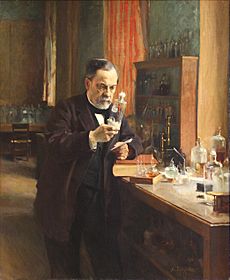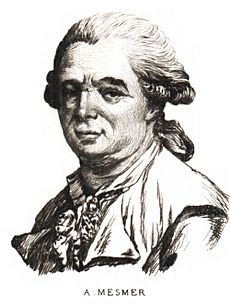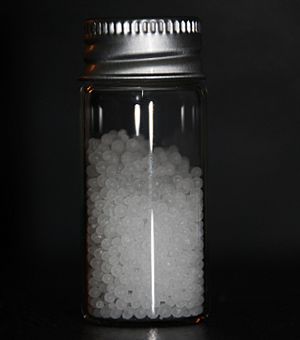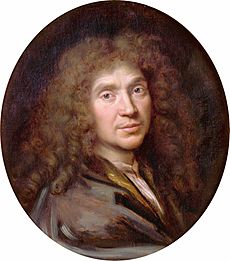Vitalism facts for kids
Vitalism is an old idea that says living things are different from non-living things. It suggests that living organisms have a special non-physical part or force that makes them alive. This special force was called many names, like "vital spark," "life energy," or "vital force." Some people even thought it was like the soul.
For a long time, scientists argued about vitalism. Some believed that all life processes could eventually be explained by physics and chemistry, just like non-living things. But vitalists argued that life was too complex and could not be explained only by mechanical rules.
Over time, scientists did experiments to test vitalism. These experiments did not support the idea. Today, most scientists believe vitalism is an outdated idea. They see it as a scientific theory that has been replaced or even a pseudoscience (a belief that pretends to be science but isn't).
Vitalism has also been important in medical ideas for a long time. Many traditional healing practices believed that sickness happened when these vital forces were out of balance.
Contents
History of Vitalism
Ancient Ideas About Life
The idea that living things have a special life force goes back a long way, even to ancient Egypt. In Greek philosophy, some thinkers tried to explain life using only natural, physical rules. But others, like Galen, believed that the lungs took in a special "pneuma" (a kind of spirit or breath) from the air, which then spread through the body.
Medieval Times
During the Middle Ages in Europe, the idea of "pneuma" continued to influence how people thought about the body and life. It even helped shape later ideas about a hidden "aether" that filled space.
Early Modern Thinkers
Many important thinkers in the 1600s and 1700s were vitalists. These included the English doctor Francis Glisson and the Italian doctor Marcello Malpighi.
Caspar Friedrich Wolff was a key figure in the study of how embryos develop. He showed that an embryo grows by making more cells, rather than just being a tiny, pre-formed creature. However, he still believed a "vis essentialis" (an organizing force) was needed to guide this growth.
In the 17th century, some scientists thought that living things changed in ways that non-living things didn't. For example, cooking permanently changes organic matter, but non-living substances can often be changed back.
In the 18th century, vitalist ideas became popular again. Doctors like Georg Ernst Stahl and Xavier Bichat believed in a life principle. John Hunter, a famous surgeon, also thought there was a "living principle" beyond just mechanics.
Johann Friedrich Blumenbach showed in 1781 that parts of a freshwater Hydra could grow back into a complete animal. He called this a "formative drive." But he also said this name didn't fully explain it. It just described a special power that combined mechanical rules with something that could change.
19th Century Discoveries
Jöns Jakob Berzelius, a founder of modern chemistry, thought a special force kept living matter working. He believed that only living things could create "organic compounds." But in 1828, Friedrich Wöhler made urea (an organic compound found in urine) from non-living chemicals. This was a big step against vitalism.
However, the idea that vitalism died right after Wöhler's discovery is a bit of a myth. It became a popular story much later.
Between 1833 and 1844, Johannes Peter Müller wrote a major book on physiology (how the body works). He described many body systems in animals. But he still believed that a soul made each organism a complete whole. He also thought that living things had a life-energy that physics couldn't fully explain.

Louis Pasteur (1822–1895) also supported vitalism with his experiments. After showing that life doesn't just appear from nowhere (spontaneous generation), he studied fermentation. He believed that fermentation was a "vital action" that could only happen in living organisms. He disagreed with others who thought it was just a chemical process.
20th Century and Beyond
Hans Driesch (1867–1941) did experiments that he thought proved life wasn't just about physics and chemistry. He found that if you cut an early embryo into pieces, each piece could still grow into a complete adult. He believed this showed a special life force at work. However, his vitalist ideas hurt his reputation as a scientist.
Today, scientists see vitalism as a theory that has been replaced. The term "vitalist" is sometimes used as a negative word. Ernst Mayr, a famous biologist, said that vitalists like Driesch were right to point out that life is more than just a machine. But he also noted that vitalism is now seen as a disreputable belief.
By 1931, most biologists had given up on vitalism as a serious scientific idea.
Emergent Properties
Modern science sometimes talks about "emergent processes." This is when a system has properties that you can't fully explain by just looking at its individual parts. This might be because the parts' properties aren't fully understood, or because how the parts interact is very important. This is different from vitalism because it doesn't suggest a non-physical force.
Mesmerism and Animal Magnetism

A popular vitalist idea in the 1700s was "animal magnetism," developed by Franz Mesmer (1734–1815). Mesmer believed this special magnetic force was only found in humans and animals. He thought it was a quality of all living creatures that breathed.
Mesmer's ideas became very popular. The King of France even set up groups to investigate them. These groups, which included famous scientists like Benjamin Franklin and Lavoisier, found that Mesmer's "animal magnetism" didn't actually exist. They concluded that people's imagination, not a special fluid, caused the effects seen in Mesmer's patients.
Vitalism in Medicine
Vitalism has a long history in medical ideas. Many traditional healing practices believe that sickness happens when vital forces are out of balance. For example, in ancient Western medicine, vital forces were linked to the four humours (body fluids). Eastern traditions talk about an imbalance or blockage of qi or prana (life energy).
Today, some alternative medicine therapies, like energy therapies, are connected to vitalism. These include practices like therapeutic touch and Reiki. In these therapies, a practitioner tries to work with a patient's "subtle energy" field. This subtle energy is thought to be beyond the normal electromagnetic energy of the body.
The founder of homeopathy, Samuel Hahnemann, believed that diseases were caused by problems with a spirit-like "vital principle" in the body. This idea is still taught in many homeopathy schools today.
Why Scientists Criticized Vitalism
One criticism of vitalism is that it doesn't really explain anything. It just gives a name to something unknown. For example, the scientist Thomas Henry Huxley joked that vitalism was like saying water is wet because of its "aquosity" (water-ness). His grandson Julian Huxley later compared "vital force" to explaining a train's movement by saying it has "locomotive force."
Another big criticism is that vitalists couldn't prove that mechanistic explanations (using physics and chemistry) were impossible. Scientists like Jacques Loeb challenged vitalists to show why living matter couldn't be made artificially. He argued that saying a "life principle" enters the egg to start life, or leaves the body at death, doesn't explain anything.
Many scientists also felt that vitalist theories couldn't be tested or proven wrong, which made them unscientific. In 1967, Francis Crick, who helped discover the structure of DNA, famously said that what people believed about vitalism yesterday, only "cranks" would believe tomorrow.
While many vitalist ideas, like Mesmerism, have been proven wrong, some untested and untestable theories still exist today, often in pseudoscientific health systems. For example, some nurses believed in "scientific theories" of spiritual healing, which were based on vitalism.
Joseph C. Keating, Jr., a chiropractor, says that vitalism is "a form of bio-theology" (a religious idea about life). He explains that vitalism tries to explain life with an "unmeasurable, intelligent force." This is circular reasoning: it says life is caused by a vital force, and the vital force is known by its effects on life. He believes vitalism is not compatible with scientific thinking.
Today, vitalism is seen as a basis for many pseudoscientific health systems. These systems often claim that illnesses are caused by problems with the body's vital force. They might say they are scientific, but they often reject the scientific method, which relies on cause and effect and being able to test ideas.
Some people try to explain these "bioenergetic" fields using ideas from quantum physics. However, scientists like Victor J. Stenger explain that energy fields are made of tiny parts called quanta and must follow the laws of physics. There is no scientific evidence that living things give off a unique energy field that goes beyond normal physics and chemistry.
Interestingly, studies have shown that young children often think about biology in a vitalistic way. They tend to choose vitalistic explanations as the most likely for how living things work.
See also
 In Spanish: Vitalismo para niños
In Spanish: Vitalismo para niños
- Energy (esotericism)
- Homeopathy
- Qi
- Royal Commission on Animal Magnetism
- Vis medicatrix naturae



